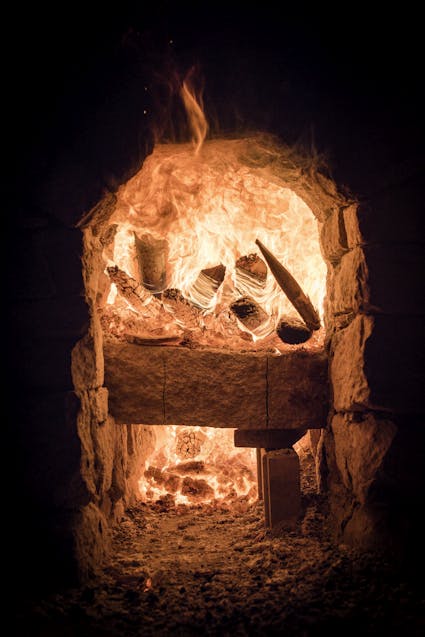Quicklime – a material thousands of years old
Archaeological findings prove that quicklime (burnt limestone) was already being produced and used thousands of years ago. One of the first construction materials to be produced artificially, it was used as a binder in lime mortar for a wide range of applications, including building, grouting and plastering, but also as a substrate for mosaics or fresco paintings. Traditional lime mortar consists of quicklime, which is dissolved (slaked) in water and mixed with sand. Knowledge of the production and use of lime mortar was passed down through the generations. As concrete began to come to the fore in the 19th century, pure lime mortar gradually receded into the background as a building material.

The production of cement and pure lime mortars involves different chemical processes for setting. The modern cement mortars used across the world nowadays bond through the addition of water (hydratation). That is not the case with lime mortar, where the lime it contains sets through the release of water and the absorption of carbon dioxide from the air. It takes significantly longer – sometimes as much as several years – for lime mortar to set than for cement mortar. On the other hand, the material offers many benefits: it is more ecologically sustainable, enables good moisture regulation and improves the indoor climate.

Burn, slake, soak
Most of the buildings in the Open-Air Museum originate from a time when the use of lime in housebuilding was still common. To repair and maintain them, the museum used to have to spend a lot of money buying the now rare construction material. The decision was then made to produce the material right here on site. Since 2000, lime has been burnt in a simple outdoor kiln in the museum. This was completely renovated in 2023.

The combustion process takes several days. First, the limestone is placed carefully in the lime kiln in layers. After it has heated up, the upper part of the kiln is covered with clay in order to retain the heat. The combustion temperature is increased to around 1000°C. During this combustion process, the limestone is transformed into quicklime, also known as lump lime. This is removed from the kiln after combustion and some of it is slaked directly, i.e. has water poured over it. In the resulting chemical reaction, the burnt stone heats the water above the boiling point and turns into a bright white, doughy mass in just a few minutes. This is filled into a lime pit, where it is stored under a layer of water. The quicklime dissolves entirely over the course of time, becoming lime putty. This is particularly suitable for the production of lime paints and fine lime plasters. The remaining burnt lime is stored in a dry place and used for the production of lime mortar as required.
For instance, it is currently being used as slaked lime in the reconstruction of the schoolhouse from Unterheid near Meiringen.

How lime mortar works – the lime cycle
Limestone consists of calcium carbonate (CaCO3). When limestone is heated to temperatures above 1000°C, the carbon dioxide (CO2) escapes, resulting in quicklime, or calcium oxide (CaO). The addition of water (H2O) leads to a chemical reaction, and under great heat, slaked lime (Ca(OH)2) is produced. The slaked lime is mixed and processed together with aggregates to form a mortar or plaster. The mortar continues to absorb carbon dioxide from the air while at the same time releasing water. This causes it to set and, from a chemical perspective, revert back to the starting material, calcium carbonate.

The lime cycle to download
Ballenberg
Swiss Open-Air Museum
Museumsstrasse 100
CH-3858 Hofstetten bei Brienz
Company holidays
24 December 2025 to 11 January 2026
Opening hours Administration
3 November 2025 to 8 April 2026
From Monday to Friday
8.30 am to 11.30 am
1.30 pm to 4.30 pm
Opening hours
9 April to 1 November 2026
10 am to 5 pm daily



